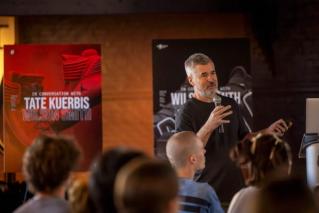Tate Kuerbis drove up to Portland, Oregon the day after he graduated design school. He began as a footwear designer at Nike, Inc. the following Monday despite never having designed sneakers. Over the course of 28 years, he amassed dozens of design credits from silhouettes developed for the likes of Dennis Rodman, Roger Federer, and Michael Jordan.
Kuerbis left the Swoosh conglomerate during Fall 2023. He still resides in the Portland area, but now he's spearheading performance footwear design at Wilson Sporting Goods, a Chicago-based institution that recently opened a design studio in the city. The decision to leave Nike, Inc. after designing important Air Jordan models wasn't easy, but Kuerbis believed it was time to try something else. Additionally, working with Wilson would allow him to inject his personal passion for tennis into the product he designs in a way he couldn't when dealing with hoops shoes.
Like former colleague Wilson W. Smith III, the industry veteran was invited to speak with students at the Savannah College of Art and Design's (SCAD) SNKR Culture Week 2025. Following the event, Kuerbis sat down with House of Heat° for a 90-minute video call through Zoom to discuss how he's helping Wilson change tennis, joining Nike during its "golden age" of footwear design, and what inspires his creativity this many years into his career.
This interview has been edited for length and clarity.
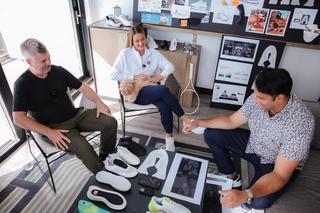
House of Heat°: What does a typical morning look like for you?
Tate Kuerbis: Things are quite different for me now that I'm not at Nike. I mean, before, it was like, jump in the car, commute for 30 to 45 minutes, find a parking spot, walk to my office, grab a coffee. I mean, it was like a whole procedure. Whereas now, working for Wilson [Sporting Goods], I'm pretty lucky that I get to work from home—although we did just open a footwear office across the river. We're very much a work remote-company, so I get to get up and work out, walk the dog, have a good coffee at home, and then settle into the day with some meetings. Then, I really just focus on design work.
Are you thinking of the more immediate things? Or are you thinking about things, let's say, 18 months out? A mix of both?
Um, things are very frantic and fast-paced. Wilson feels more like a startup, even though the company is over 100-years-old. We have a ton of heritage, a ton of footwear in the vaults. I mean, we’re just sitting on a gold mine of stories to tell, product to reimagine. I'm in charge of working on Wilson’s performance footwear—primarily tennis, some pickleball and padel.
When I started this job, I jumped into launching a whole new tennis line specifically designed for Women's tennis. No company had ever really done this before. At the time, we were already eight months behind schedule from development and design standpoints. Basically, I had a year to design three shoes and one of those was gonna go on our top female athlete, Marta Kostyuk. We scanned like one thousand women's feet to get a specific Women's fit. We set the bar really high for what we wanted this Wilson footwear line to look like, re-entering the market with some really fresh and modern designs.
You’re talking about the Wilson Intrigue line, correct?
Yeah, the Intrigue.
I saw that it was voted “Best New Tennis Shoe” by Women's Health magazine. How does that feel? What were some of the challenges that you faced in spearheading this Women’s-specific line?
I was honored to see that award. It really speaks to teamwork; we’re a small team.
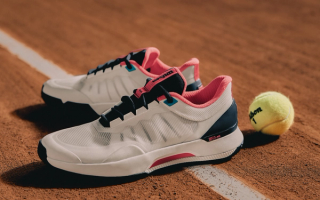
I was used to being at Nike and Jordan, where you had any resource at your fingertips that you might’ve wanted. Then I came to Wilson and was like, “Wait a minute, we don't have a materials designer? We don't have a color designer? We don't have an engineer? We don't have”—I mean, the list just goes on and on. It was like, “Okay, we’re just gonna do things with the people we have.” As stressful as it was, it was kind of, like, refreshing to really be able to feel like you're creating something from scratch with a really small team without layers and layers of people above you, having to consider their input and opinions.
I was just flying to Asia—going to the factory as much as possible—meeting with the athletes; flying to Monte Carlo like three times to meet with Marta just to get the fit right. It was nice to have the freedom to only be like three or four people creating this product. No challenge was too difficult, even though at times it felt like we were up against the wall. Sure enough, we had a meeting with Marta three months before the U.S. Open and then she wore it at the U.S. Open. To see her wearing it on the court—in one of the biggest tournaments, in front of all those people—made me super proud of what we did together.
I think recognition from Women's Health is great, but if the athlete you're focusing on is able to do what she does on court, that speaks for the product as well.
Yeah. We really wanted to focus on her input, which was, ‘I love running shoes. I love the way they feel, the comfort.’ We took that and blended it with high-performance needs on the court to create a super comfortable, really easy-to-wear tennis shoe.
How were the teams when you got to Nike back in the ‘90s?
It was completely different in ‘95.
I got the job, drove up to Nike day after I graduated from design school in [Los Angeles] and went to work on Monday. I show up and there’s just a table there—no laptop, no computer. Everything was drawn by hand. I had never in my life drawn a sneaker, even when I interviewed to work at Nike; I didn't have a portfolio of sneakers. I didn't go to school for sneaker design— there was no such thing. I didn't even really realize that there was a someone designing shoes, I just kind of thought shoes just showed up.
I sat at that desk not knowing a single thing about footwear. Nothing. There really wasn’t a foundation program, or, you know, something to educate you. It was pretty much just, ‘Jump right in; Here's your first project; Figure it out.’ I learned as much as possible from people like Eric Avar—he was the one designing all the [Nike] Basketball stuff. I started at Nike Basketball. I was just amazed at what he was doing—the Foamposites, Uptempos, the Pennies. I tried to incorporate that into my work, even though I was really new to everything.
You guys must have felt that you were onto something when it came to certain product that’s since withheld the test of time.
Yeah. I really felt it was the “golden age” of footwear back then. Every time samples came into the office, I was like Christmas. You're opening up these boxes and seeing shoes for the first time that you had never seen in your life—new technologies like Foamposite. When I saw it for the first time I saw, I was like, “Oh my gosh, this is futuristic, space-age stuff!” Now, I feel like people aren't as moved, or, like, you just see so much now. Everything has kind of been done and we're flooded with so many footwear designs.
Very, very rarely do I see a shoe that I'm like, “Wow, that is something that I've never seen before,” I can't stop looking at it kind-of-thing. Back then, every shoe was like something new and that was great. It was so much fun.

Do you credit this to a design zeitgeist people were tapped into? New material advancements and discoveries? New manufacturing processes?
I think you’re right on with new manufacturing technologies.
When I started, there was a lot of stitch-and-sew. You had a bunch of leathers—maybe synthetic leathers—some textiles, and you just stitched-and-sewed everything together. As soon as we figured out how to start developing product with no sewing, without stitching—like I mentioned, the Foamposite was completely different from a construction standpoint—it helped speed up and modernize things, more than anything, from an aesthetic and production standpoint.
Before, you only had a few ingredients and then, every week you'd get more ingredients; all of a sudden, you're like, “Oh! I could bake this cake and I could add this to it,” whereas before, you only had, like, three ingredients. After a while, that gets kind of boring—there’s only so much you can make with three ingredients. When you have one hundred ingredients, you're like, “Wow! I can really make some amazing product that's never been seen before.” We had Nike Air technology and then they started coming out with new Airbags like Zoom Air. And then Shox. I mean, everything evolved so quickly. It was just really a ton of fun to be working on product back then.
One more thing in there: moving from pen and paper to the computer, I don’t know if it was a good thing because, I mean, it definitely sped up the design process, but it kind of took away that hand-touch, you know? When things were drawn—I mean, I don’t think Tinker [Hatfield] ever used a computer in his life—I think that's what gave every design he did this human touch. The lines weren't perfect, things were kind of, you know, not totally refined.
You were at Nike, Inc. for 28 years. What informed your decision to leave and join Wilson?
It wasn't an easy decision, but I did feel like it was time to experience something else. I knew I had a ton of tools in my tool chest that could work at a company like Wilson. I could never really get myself to be interested in going to adidas or New Balance—to a company that was almost the same as Nike. I felt like Wilson was this untapped company that, like I said, has a lot of heritage. Wilson is really true to tennis. It is a tennis company more so than, I think, Nike Tennis ever was.
Nike had a ton of money to spend to get the top athletes, but tennis was a small blip on the screen for Nike. It would get more popular at certain times but it never felt like the big business or opportunity there. With Wilson, that's their business and to have them be like, ‘Here are the keys—go reimagine what Wilson Footwear is gonna look like in next two to five years; set a design strategy; build beautiful product, work with athletes; just go for it,’ this was an opportunity of a lifetime.
Working with [Michael Jordan] was unimaginable, and a super honor, but I wasn't ever playing basketball; I didn't really know what it was like to be that tall and be on the court, so I was just trying to design product that I thought would perform really well. I'm not saying I’m a pro player or anything, with tennis, I have those experiences that [inform product design]. It's just something I'm really passionate about.
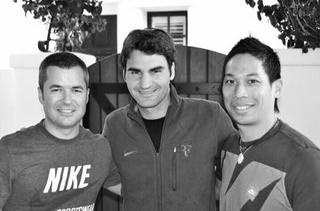
You mentioned a getting the keys to building the future of Wilson Performance. What are some of the elements you want Wilson Footwear to be recognized for over the next five to 20 years?
Great question.
I look at Wilson as the premium tennis brand. Before I even joined Wilson, I looked at their tennis apparel. It was all just super simple, classic, not over-designed, very wearable. and timeless. When you looked at the footwear, it didn't really match what the Apparel team was doing. I felt like I could bring what I worked on at Jordan Brand to Wilson and really just simplifying things to create iconic product that is well-crafted, and complemented the apparel.
With a lot of tennis footwear, it looks like you’re wearing equipment for your feet. I felt like we could clean the slate a little bit and be more calm about things while making sure the performance is there, but not in your face or overdone.
People might know Wilson through a basketball or baseball glove, but footwear is really kind of untapped and unknown. We have a super long runway ahead of us. It's fun to be the underdog, to take on the big companies. I’m super excited for the future.
You spoke at the Savannah College of Art and Design’s SNKR Culture Week in October, a program centered on sneaker design. How was that?
Yeah, I didn't have any like that when I was in design school. went into my first job not knowing anything about shoes.
I think it's such a great idea that SCAD brings in people from the industry to [allow students to see] what goes on behind the “curtains” [of the industry]. I wanted to show them a day in the life of a footwear designer—what it takes to kick off a new season, get a brief, start sketching, meeting with an athlete. I didn't sugarcoat anything. I just wanted to show it's not all fun and simple.
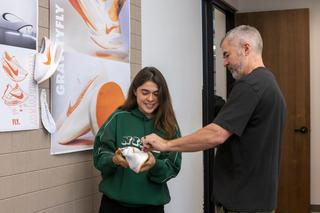
[SNKR Culture Week] was an opportunity to really show the design process and educate the students. All the students were amazing. There was definitely a difference in the level of talent—like some were really raw, trying to figure things out, and others could get a job right now.
I wish I would have had something like that when I was at school, but I didn't. Kids are lucky these days to have an opportunity to go to an amazing school like SCAD and learn from amazing teachers, industry people. There’s definitely a lot of talent coming out of there.
Could you share what it was like pitching to Michael Jordan?
With the [Air Jordan 18], I was like, “Wow…what did I just sign myself up for?” I mean, I had only been at Nike and Jordan for maybe six years? To step into a project like, ‘You’re gonna design the next game shoe,’ was—you know, Tinker had worked on the [Air Jordan] 3 through 15, and I saw what Wilson [W. Smith III] went through on the 16 and 17—so it was a lot to grasp at that time. Michael was still playing. I was still trying to define who I was as a person and designer. It was a long 18 months of working on that, too.
Thankfully, MJ got it. He spent all those year with Tinker, so he was one of the rare athletes that could really go deep into both performance and design. Meeting with him, getting his input and direction set the pathway to designing the game shoe. It wasn’t like, ‘Here's the design, go do it,’ it was just his words that gave me the inspiration to create the product. At the same time, you’re getting all this feedback from upper management and you're like, “Who do I listen to? I got 10 different people telling me10 different things,” but I would always just back to MJ because he's who I was designing the shoe for. I thought, “I hear all of you, but this is what MJ is telling me, so that’s what I'm gonna do and there's nothing you could say.”
Getting him onboard and making sure he liked the product was always a bit nerve-wracking, but when did, I thought, “I can actually sleep tonight!” It was quite the experience, to say the least.
Was there a particular design that he was most vocal about?
Yeah, he was. I wish I had the prototype with me. He's really good at, like, you could show him drawings, of course, but he really wanted to see the product. He could see the vision, which was really great.
On the 18, he was, he had these super expensive driving shoes made in Italy. Handcrafted. The stitching was beautiful. The leather was beautiful. They had rubber wrapping up the back 'cause it was a driving shoe. He had this new Ferrari in his garage. He said, ‘Hey, I would love if you could make a basketball shoe that looked like one piece of leather that was just so clean and wrapped around the whole shoe.’ I thought, “That's cool. I could do that. I could figure that out.” And so I did exactly that—built a shoe that was all leather. It still had the lacing exposed, but the leather went all the way down to the rubber. The shoe was double-lasted, simple, and basic-looking. It wasn't enough. I showed him that sample and he was like, ‘I get where you're going, but there still has to be something else to it, another element—performance or otherwise. Think back to the Ferrari: it’s simple, it's beautiful, it’s got all this tech inside.’ I took that and started adding more to the bottom of [the shoe] 'cause I pictured Michael Jordan flying through the air. He was always, like, just gliding through the air, effortlessly, hovering on the basketball court. That’s why I added blue TPU on the bottom: it made it look like he was walking on water or something.

Everything else was super simple. Rubber wrapped up the back. I also put a shroud on it and little wings that kind of looked like a sports car. It was all beautifully crafted. It all came together at the very end. I just hoped the public liked it because I didn’t want to be the first guy to mess up an Air Jordan. My career would be ruined. But it all came together and then, he retired in the 18s. So, I was like, “Hopefully it wasn't because of the shoes.” I'm honored that he retired in something that I designed for him.
Is there anything related to the Air Jordan 18 that you would’ve changed had you known he was going to retire in it?
I think the shoe was done before we knew he was gonna retire. I think if we knew he was gonna retire in the 18, we might have done a celebration or something to make it into something bigger. But, I look at the 18 and I'm very comfortable. I'm a very hard critic on my own designs—there are a lot of shoes I wish I would have done differently— but I look at the 18 and I'm really happy with where it landed. I'm happy that it re-released in 2018 with some different colorways. [The retros] looked really cool. I think it stood the test of time.
You’re widely associated with Air Jordan designs that have been lauded by hardcore hoopers, but overlooked by the lifestyle-oriented consumer. Were you cognizant of this gap and did it ever inform your design work?
Yeah, 100%.
The [Air Jordan] 31 was interesting 'cause MJ was like, ‘Hey, you're working on the 31. Why start from scratch when you could go back and look at the [Air Jordan] 1 to inspire the 31?’ So, that’s where we started with the 31.
The blending of the 1’s original vision with the 31 kind of continued into the 32. As we got to the 33, I was fortunate enough to work with Ross Klein, who was in charge of Nike Innovation for Basketball and also Jordan Innovation for Basketball. He was probably one of the best collaborators I've ever worked with in my career. Things weren’t about him, they were about the product. He had worked and collaborated with Eric Avar and Tinker, and was just all about creating amazing products. His point was, ‘We need to take over the court. We need to be the best performance basketball shoe on the court, the Air Jordan. It needs to perform first and foremost.’ MJ totally believed in that, as well, so we focused on that with the 33. As we got to the 34, it was very evident that that's what we were gonna do from day one: take over the court. We hoped it would translate onto the streets, with sneaker culture, but we really focused on performance first.
We were always mapping out the next three years. “How does the 34 evolve into the 35 and to the 36?” We kept that Eclipse plate until the 36 because we wanted to do it in threes. Then it was time for new innovation, but it's important to make sure that innovation is not just a gimmick.
I'm a big fan of what Ross Klein has done with the Nike LeBron 23.
He's super talented and I love what he did with the LeBron.
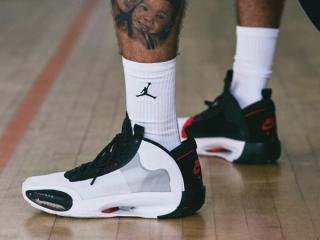
Outside of the Air Jordan series, you worked on the Jordan Trunner line. Are you familiar with the Trunner O/S?
Yeah. I saw it in Chicago last week when I was there. At Notre?
What do you think about a non-Air Jordan series lasting over 20 years?
I think it's cool. I thought the original Trunner Tinker did was really super cool. I still think that it looks cool even today. Um, with the wrapped, swayed on the heel, and the circle, and the jump in, and the strap. I mean, it was just super cool. It's kind of fun that Jordan's bringing it back.
These projects were always really hard at Jordan, stuff that wasn't pure basketball performance or the game shoe. We tried a lot of stuff back then; we tried to bring running to Jordan Brand in, like, 2017 and ’18, but, you know, if you’re not an authentic running brand, it's hard to bring running shoes to market.
I think the Jumpman has so much potential. They could go sign a tennis athlete and put them in Jordan tennis shoe; sign a soccer player and put them in a Jordan cleat, you know? The Jumpman means everything to everyone, practically.
If you had to pick one project that best represents your identity as a designer, which would it be and why?
I'll just go back to the 18. It kind of established me as a designer.
If we have this conversation five years from now, it'll be interesting to see what my answer would be.
Who are some of the people, places, and things that inspire you?
Oh, wow. There are so many things. I think, my experience working with a lot of the designer like Wilson Smith, Ross Klein, and then some of my PLMs [Product Line Managers]. I think working with athletes is amazing because you see the amount of dedication and time they spend on their craft. They truly inspire me to help them perform better, whether it's Michael Jordan or the 300th ranked player trying to get on the ATP tour.
I like seeing unexpected things, like architecture, or going into museums, seeing furniture design, or paintings. Restaurants. I love going into restaurants and seeing how they're designed, or bars, and seeing how they tell a story.

When it's all said and done, how would you like your legacy to read?
Man, these are deep questions…
I would love people to remember me as a good designer that cared about the product and the athlete. Also, someone who was easy to work with and didn't have an ego, who really believed in teamwork and collaboration. Someone who was just trying to create the best product, who never gave up, no matter how hard the situation was.
—
JOVANI HERNANDEZ IS HOUSE OF HEAT°’S LEAD WRITER.
